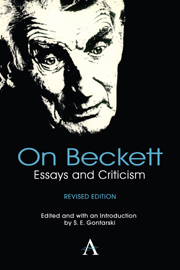Book contents
- Frontmatter
- Contents
- The Essential Beckett: A Preface to the Second Edition
- A Beckett Chronology
- Acknowledgments
- Crritics and Crriticism: “Getting Known”
- Preliminaries
- The Page
- The Stage
- MacGowran on Beckett
- Blin on Beckett
- Working with Beckett
- Notes from the Underground: Waiting for Godot and Endgame
- Beckett Directs Godot
- Beckett Directs: Endgame and Krapp's Last Tape
- Literary Allusions in Happy Days
- Counterpoint, Absence, and the Medium in Beckett's Not I
- Rehearsal Notes for the German Premiere of Beckett's That Time and Footfalls
- Footfalls
- Samuel Beckett and the Art of Radio
- Light, Sound, Movement, and Action in Beckett's Rockaby
- Beckett's Ohio Impromptu: A View from the Isle of Swans
- Quad and Catastrophe
- Coda
- Notes on Contributors
Light, Sound, Movement, and Action in Beckett's Rockaby
from The Stage
Published online by Cambridge University Press: 05 May 2013
- Frontmatter
- Contents
- The Essential Beckett: A Preface to the Second Edition
- A Beckett Chronology
- Acknowledgments
- Crritics and Crriticism: “Getting Known”
- Preliminaries
- The Page
- The Stage
- MacGowran on Beckett
- Blin on Beckett
- Working with Beckett
- Notes from the Underground: Waiting for Godot and Endgame
- Beckett Directs Godot
- Beckett Directs: Endgame and Krapp's Last Tape
- Literary Allusions in Happy Days
- Counterpoint, Absence, and the Medium in Beckett's Not I
- Rehearsal Notes for the German Premiere of Beckett's That Time and Footfalls
- Footfalls
- Samuel Beckett and the Art of Radio
- Light, Sound, Movement, and Action in Beckett's Rockaby
- Beckett's Ohio Impromptu: A View from the Isle of Swans
- Quad and Catastrophe
- Coda
- Notes on Contributors
Summary
Rockaby, which had its world premiere performance in Buffalo, New York, on 8 April 1981, continues Beckett's recent preoccupation with a small-scale play written specifically for a prerecorded voice in conflict with live stage action. A strange mixture of the carefully controlled and the spontaneous, the drama, whose sole protagonist is a woman dressed in black and whose only scenery is a rocking chair, restricts its subject matter and directs our attention instead to the formal elements of the play as performance. Light, sound, movement, and action therefore must be understood within the context established by this deliberately circumscribed stage space, an acting area in which a single image is expressed, explored, and advanced. Clear, articulate, definite, and precise, the visual impact becomes progressively haunting in its lonely simplicity. Simultaneously remote yet urgent in its personal appeal, a human shape is transfixed by the strong and pitiless light of a cold lunar glare. Much is made out of almost nothing.
What Rockaby gives up in breadth it makes up in fineness. The closely valued harmonics in the interplay of all that is visual and verbal, the use of light, the rocking of a chair that is controlled mechanically, the function of movement to emotionalize meaning, and the incorporation of electronics in the form of a magnetic recording tape are developed tactfully and richly.
- Type
- Chapter
- Information
- On BeckettEssays and Criticism, pp. 292 - 298Publisher: Anthem PressPrint publication year: 2012



